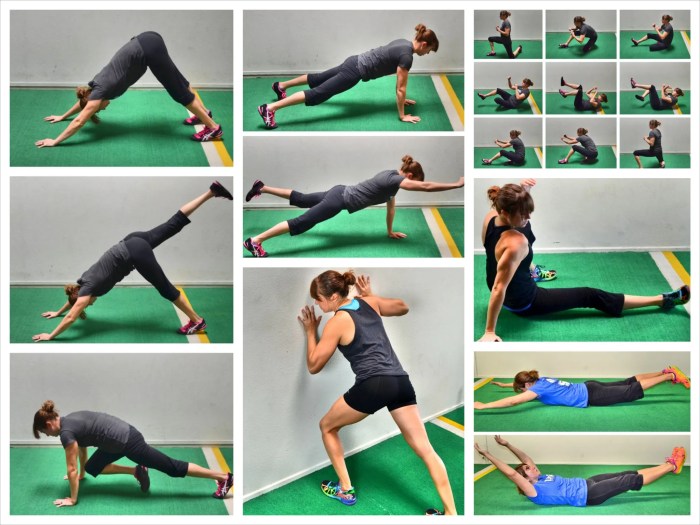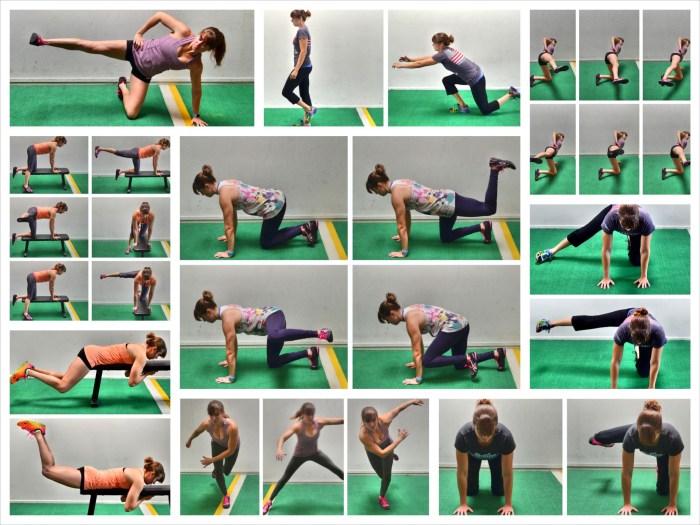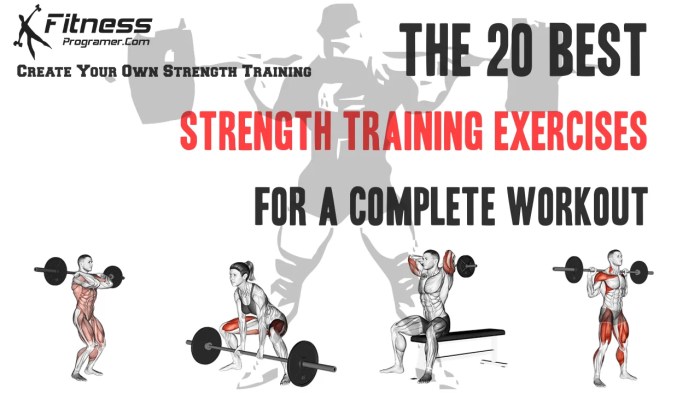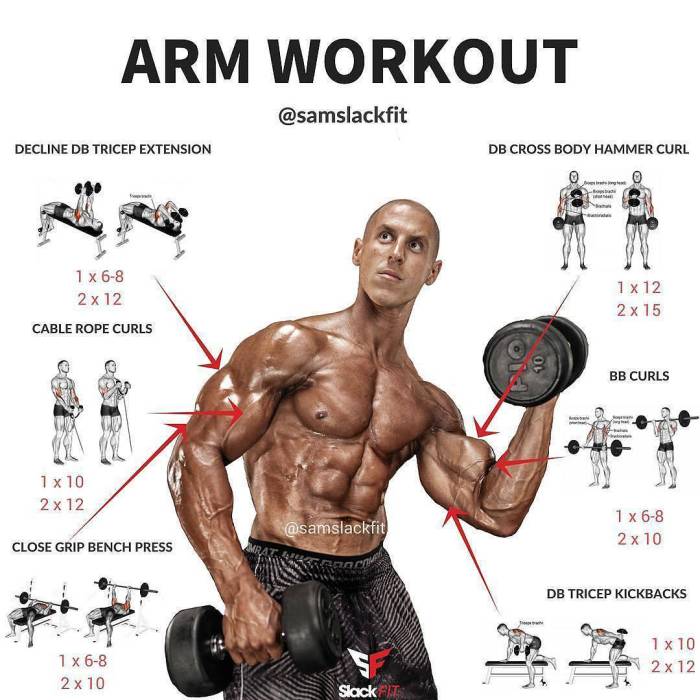Best exercises to build strength – Welcome to your ultimate guide to building strength! Here, we’ll delve into the world of the best exercises to help you achieve your fitness goals. From understanding the basics to mastering advanced techniques, this comprehensive guide will equip you with the knowledge and tools to unlock your strength potential.
Whether you’re a seasoned athlete or just starting your fitness journey, this guide will provide you with everything you need to know about building strength effectively and safely.
Introduction
When it comes to building strength, not all exercises are created equal. The “best” exercises are those that target multiple muscle groups, allow for progressive overload, and promote proper form. Strength training is essential for improving overall fitness, reducing the risk of injury, and boosting metabolism.
Here’s a list of exercises widely considered the “best” for building strength:
- Barbell squats
- Bench press
- Deadlifts
- Overhead press
- Pull-ups
- Rows
- Lunges
- Planks
Each of these exercises targets specific muscle groups and contributes to overall strength development.
Compound Exercises

Compound exercises are a type of exercise that works for multiple muscle groups at once. This makes them very efficient for building strength, as you can work more muscles in a shorter amount of time.
Some of the best compound exercises for building strength include:
| Exercise | Muscles Worked |
|---|---|
| Squat | Legs, glutes, core |
| Deadlift | Legs, back, glutes |
| Bench press | Chest, shoulders, triceps |
| Overhead press | Shoulders, triceps, core |
| Barbell row | Back, biceps, core |
Compound exercises are a great way to build strength because they allow you to work multiple muscle groups at once. This makes them very efficient, as you can work more muscles in a shorter amount of time. Compound exercises also help to improve your balance and coordination, and they can help to reduce your risk of injury.
Benefits of Compound Exercises for Building Strength
- Compound exercises work for multiple muscle groups at once, making them very efficient for building strength.
- Compound exercises help to improve your balance and coordination.
- Compound exercises can help to reduce your risk of injury.
Isolation Exercises

Isolation exercises are designed to target specific muscle groups by limiting the involvement of other muscles. This allows for focused development and isolation of the targeted muscle, resulting in improved strength and muscle definition.
Benefits of Isolation Exercises
- Improved muscle definition and isolation
- Enhanced strength in specific muscle groups
- Improved muscular endurance
- Reduced risk of injury by strengthening individual muscles
Top Isolation Exercises
| Exercise | Target Muscle Group |
|---|---|
| Barbell Curl | Biceps |
| Triceps Pushdown | Triceps |
| Leg Extension | Quadriceps |
| Hamstring Curl | Hamstrings |
| Calf Raise | Calves |
| Lateral Raise | Lateral Deltoids |
| Rear Delt Fly | Rear Deltoids |
| Front Raise | Anterior Deltoids |
| Crunches | Abdominals |
| Plank | Core Muscles |
Proper Form and Technique
Proper form is crucial for maximizing the benefits and minimizing the risk of injury. Focus on isolating the target muscle group by controlling the movement and avoiding momentum. Choose a weight that challenges you while maintaining good form. Aim for 10-15 repetitions per set, with 3-4 sets per exercise.
Rest and Recovery
Adequate rest and recovery are essential for muscle growth and repair. Allow for 1-2 minutes of rest between sets and 24-48 hours of rest before training the same muscle group again. Listen to your body and take rest days when necessary.
Progressive Overload

Progressive overload is a fundamental principle of strength training that involves gradually increasing the stress placed on your muscles over time. This forces them to adapt and grow stronger.
There are several ways to apply progressive overload to your workouts:
Increasing Weight or Resistance
- Gradually increase the weight you lift or the resistance you use.
- For example, if you’re currently bench pressing 100 pounds, aim to increase it to 105 pounds in your next workout.
Increasing Volume
- Increase the number of sets or repetitions you perform.
- For instance, if you’re currently doing three sets of 10 reps, increase it to three sets of 12 reps.
Decreasing Rest Time
- Reduce the amount of rest you take between sets.
- For example, if you’re currently resting for 60 seconds between sets, reduce it to 45 seconds.
Increasing Frequency
- Increase the number of times you train per week.
- For example, if you’re currently training three times per week, increase it to four times per week.
Frequency and Volume

The optimal frequency and volume of strength training depend on your fitness level and goals. If you’re new to strength training, start with 2-3 sessions per week, focusing on compound exercises. As you get stronger, you can increase the frequency and volume of your workouts.
Frequency, Best exercises to build strength
The optimal number of strength training sessions per week depends on your fitness level and goals. If you’re new to strength training, start with 2-3 sessions per week. As you get stronger, you can increase the frequency of your workouts to 4-5 sessions per week.If you’re training for strength, aim for 8-12 repetitions per set.
If you’re training for power, aim for 6-8 repetitions per set. If you’re training for hypertrophy, aim for 10-15 repetitions per set.
Volume
The total number of sets and repetitions per workout depends on your muscle group and exercises. For example, you can do 3 sets of 10 repetitions for each exercise in a compound exercise workout. For isolation exercises, you can do 2-3 sets of 10-15 repetitions per exercise.
Progression
As you get stronger, you’ll need to gradually increase the frequency and volume of your workouts to continue to make progress. You can do this by adding more sets or repetitions to your workouts, or by increasing the weight you’re lifting.It’s important to rest and recover between workouts.
This will allow your muscles to repair and grow stronger. Aim for at least 24 hours of rest between workouts for each muscle group.Here is a sample workout plan that you can follow: Monday:* Barbell bench press: 3 sets of 8-12 repetitions
Dumbbell rows
3 sets of 8-12 repetitions
Overhead press
3 sets of 8-12 repetitions Tuesday:* Rest Wednesday:* Squats: 3 sets of 8-12 repetitions
Leg press
3 sets of 8-12 repetitions
Hamstring curls
3 sets of 8-12 repetitions Thursday:* Rest Friday:* Pull-ups: 3 sets of 8-12 repetitions
Chin-ups
3 sets of 8-12 repetitions
Bicep curls
3 sets of 8-12 repetitions Saturday:* Rest Sunday:* RestThis is just a sample workout plan. You can adjust it to fit your own fitness level and goals. It’s important to listen to your body and rest when you need to.
Nutrition

Nutrition plays a pivotal role in building strength. It provides the building blocks and energy required for muscle growth and repair.
Here are some key nutritional guidelines for strength training:
Protein Intake
Protein is essential for muscle growth and repair. Aim for a daily protein intake of 1.6-2.2 grams per kilogram of body weight.
Calorie Surplus
To gain strength, you need to consume more calories than you burn. Aim for a calorie surplus of 250-500 calories per day.
Hydration
Water is crucial for muscle function and recovery. Drink plenty of water throughout the day, especially before, during, and after workouts.
Recovery
Recovery is an essential aspect of building strength. During exercise, muscles undergo micro-tears and inflammation. Recovery allows these muscles to repair and rebuild, leading to increased strength and muscle mass.
Recovery involves both physiological and neurological processes. Physiologically, muscles need time to repair damaged tissue and replenish energy stores. Neurologically, the nervous system needs time to recover from the demands of exercise.
Sleep
Sleep is crucial for recovery. During sleep, the body releases hormones that promote muscle growth and repair. Aim for 7-9 hours of quality sleep each night.
Stretching
Stretching helps improve flexibility and range of motion, which can reduce muscle soreness and improve recovery. Incorporate both dynamic and static stretching into your routine.
Foam Rolling
Foam rolling is a self-massage technique that can help reduce muscle tension and improve circulation. Use a foam roller to apply pressure to tight muscles, holding each position for 30-60 seconds.
| Recovery Strategy | Benefits | Frequency |
|---|---|---|
| Sleep | Muscle growth and repair | 7-9 hours per night |
| Stretching | Improved flexibility and range of motion | Daily |
| Foam Rolling | Reduced muscle tension and improved circulation | 2-3 times per week |
Recovery is essential for maximizing strength gains. By prioritizing sleep, stretching, and foam rolling, you can optimize your recovery and achieve your strength-building goals.
Sample Strength Training Plan

For beginners, starting a strength training program can be daunting. Here’s a sample plan to help you get started.
Table: Sample Strength Training Plan
| Exercise | Sets | Reps | Rest Period |
|---|---|---|---|
| Barbell Squat | 3 | 8-12 | 1-2 minutes |
| Bench Press | 3 | 8-12 | 1-2 minutes |
| Barbell Row | 3 | 8-12 | 1-2 minutes |
| Overhead Press | 3 | 8-12 | 1-2 minutes |
| Leg Press | 3 | 8-12 | 1-2 minutes |
Note:Warm up with 5-10 minutes of light cardio and dynamic stretching before each workout. Cool down with 5-10 minutes of static stretching after each workout.
Final Conclusion
Incorporating these exercises into your routine, along with proper nutrition, rest, and recovery, will set you on the path to building a stronger, more capable body. So, let’s get started on your strength-building journey today!
FAQ: Best Exercises To Build Strength
What are the most effective exercises for building strength?
Compound exercises, such as squats, deadlifts, and bench press, are highly effective for building overall strength.
How often should I strength train?
For optimal results, aim for 2-3 strength training sessions per week, allowing for rest and recovery in between.
How can I track my progress in strength training?
Keep a workout log to record your sets, reps, and weight used. This will help you monitor your progress and make adjustments as needed.
Is it safe to lift heavy weights?
Lifting heavy weights can be safe and beneficial when done with proper form and technique. Always start with a manageable weight and gradually increase it over time.
Leave a Reply